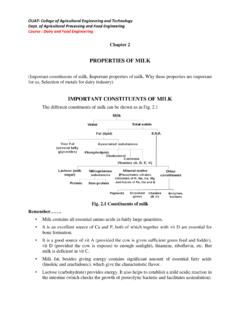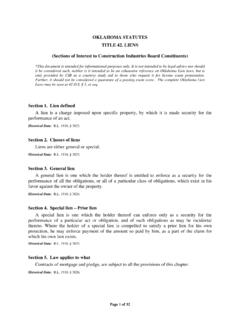Transcription of Processing of Aloe Vera Leaf Gel: A Review
1 American Journal of Agricultural and Biological Sciences 3 (2): 502-510, 2008 ISSN 1557-4989 2008 Science Publications Corresponding Author: Ramachandra, Department of Agricultural and Food Engineering, Indian Institute of Technology, Kharagpur-721302, India Tel: +919449627325 Fax: +913222282244 502 Processing of Aloe Vera Leaf Gel: A Review Ramachandra and P. Srinivasa Rao Department of Agricultural and Food Engineering, Indian Institute of Technology, Kharagpur-721302, India Abstract: Proper scientific investigations on Aloe vera have gained more attention over the last decade due to its reputable, medicinal, pharmaceutical and food properties. Some publications have appeared in reputable scientific journals that have made appreciable contributions to the discovery of the functions and utilizations of Aloe vera lacking Processing of leaf gel.
2 Present Processing techniques aims at producing best quality aloe products but end aloe products contain very little or virtually no active ingredients. Hence, appropriate Processing techniques should be employed during Processing in order to extend the use of aloe vera gel. Further research needs to be done to unravel the myth surrounding the biological activity and the exploitation of aloe constituents. Key words: Cold process, Qmatrix process, whole leaf process, desiccant air dehydration, time temperature, sanitation process INTRODUCTION Aloe vera (Aloe barbadensis Miller) is a perennial plant of liliacea family with turgid green leaves joined at the stem in a rosette pattern. Aloe vera leaves are formed by a thick epidermis (skin) covered with cuticle surrounding the mesophyll, which can be differentiated into chlorenchyma cells and thinner walled cells forming the parenchyma (fillet).
3 The parenchyma cells contain a transparent mucilaginous jelly which is referred to as Aloe vera gel. Potential use of aloe products often involves some type of Processing , heating, dehydration and grinding. Processing may cause irreversible modifications to the polysaccharides, affecting their original structure which may promote important changes in the proposed physiological and pharmaceutical properties of these constituents. Processing of Aloe vera gel derived from the leaf pulp of the plant, has become a big industry worldwide due to the application in the food industry. It has been utilized as a resource of functional food, especially for the preparation of health drinks which contain Aloe vera gel and which have no laxative effects. It is also used in other food products, for example, milk, ice cream confectionery and so on.
4 However, Aloe vera gel juice was not very popular due to their laxative effect and majority of them contained absolutely no active mucilaginous polysaccharides or acemannan. Although colour changes have little relation to the therapeutic effectiveness of stabilized gel, they are rarely acceptable psychologically to the user. The color change is totally unacceptable in some products. It therefore becomes imperative that a simple but efficient Processing technique needs to be developed, especially in the aloe beverage industry, to improve product quality, to preserve and maintain almost all of the bioactive chemical entities naturally present in the plant during Processing . The production process of aloe products involve crushing, grinding or pressing of the entire leaf of the Aloe vera plant to produce an Aloe vera juice, followed by various steps of filtration and stabilization of the juice.
5 The resulting solution is then incorporated in or mixed with other solutions or agents to produce a pharmaceutical, cosmetic or food product. In the food industry, Aloe vera has been utilized as a resource of functional food, especially for the preparation of health food drinks and other beverages, including tea. The amount of Aloe vera that finds its application in the pharmaceutical industry in not negligible as far as the manufacturing of topical ointments, gel preparations, tablets and capsules are concerned. Aloe vera gel also finds its application in the cosmetic and toiletry industries, where it is used as a base for the preparation of creams, lotions, soaps, shampoos and facial cleaners. Unfortunately, because of improper Processing procedures, many of these so-called aloe products contain, very little or virtually no active ingredients, Am.
6 J. Agril. & Biol. Sci., 3 (2): 502-510, 2008 503 namely, mucopolysaccharides. In view of the known wide spectrum of biological activities possessed by the leaves of the Aloe vera plant and its wide spread use, it has become imperative that the leaf be processed with the aim of retaining essential bioactive components. The Review aims to provide a succinct resume of information regarding Aloe vara to serve as a reference for further investigations about this potential ingredient, to develop an effective method for Processing of Aloe vera leaf, in the process, preserve and maintain almost all of the bioactive chemical entities naturally present in the Aloe vera leaf. The analysis deals with biological activity of leaf gel, gel stabilization technique, heat treatment of leaf gel, Processing methodologies like cold-process, whole leaf process Qmatrix process, activealoe process, desiccant air dehydration, total process Aloe vera and Time Temperature and Sanitation (TSS) process.
7 BIOLOGICAL ACTIVITY OF ALOE VERA The controversy over the identity of the active substance(s) in Aloe vera has not been settled. Also, various mechanisms have been proposed for the alleged healing properties of Aloe vera. Since no single definitive active ingredient has been found, it is commonly suggested that there may be some synergitic action between the polysaccharide base and other components[1]. According to Mackee[2], vitamin D was the healing agent, but Row and Parks[3] reported the absence of vitamin D. Morton[4] suggested a theory stating the seeming efficacy of aloe pulp may be attributed to its high water content, , 96%+, providing a means of making water available for injured tissue without sealing it off from the air. This recovery would explain the instant soothing effect of Aloe vera gel has on burns, but would not account for the long term effect of healing.
8 The action of Aloe vera is simply due to its moisturizing and emollient effects, hence, its use in cosmetics. Various researchers reported that the effective components for wound healing may be tannic acid[5] and a type of polysaccharide[6]. Other researchers have also reported anti-inflammatory effects of complex polysaccharides, glycoproteines and sulfated polysaccharides. However, there are many examples in the literature indicating that polysaccharides can exhibit pharmacological and physiological activities without help from other components. It is therefore, logical that the mucilaginous gel of Aloe vera plant, which is essentially a polysaccharide, holds secrete to Aloe vera s medicinal properties. Many researchers such as Collins and Collins[7], Fine and Brown[8] and Crew[9] have attributed pain-relieving properties to Aloe vera gel.
9 It is virtually impossible to prevent contamination by the leaf exudates during commercial extraction of Aloe vera gel. It is also believed that the intact leaves anthraquinones and their derivatives may diffuse into the gel from the bundle sheath cells; this possibly supports the conclusion of Row et al.[10], who states that the healing agent is passed from the rind into gel on standing. Davis[11], using the conductor-orchestra concept, explains the relationship that exists among over 200 biologically active compounds within Aloe vera. One of these molecules, a polysaccharide and acts as the conductor that leads a symphony composed of 200+ biologically active compounds. Davis concluded that, as the conductor, the polysaccharide modulates the biological activity between the surrounding orchestra molecules to work synergitically.
10 In view of these findings, it has seen presumptuous for any scientific research to consider or even to postulate that any one substance is responsible for the biological activity seen in Aloe vera gel. Unfortunately, it is not easy to differentiate between a good quality product and one that has been adulterated. Although price can be a guide-the more expensive the Aloe vera, the better the product-this does not always apply. In the end, the key to judging Aloe vera is by results. The things that happens to make aloe products less desirable or cause it to become virtually non beneficial are stem from the harvesting of the leaves, Processing and distribution of leaves. The freshly removed leaves must go directly into production or must be appropriately refrigerated to prevent a loss of biological activity, principally through the degradative decomposition of the gel matrix.







